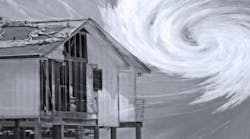What can dentists learn from natural disasters?
This article originally appeared in the Principles of Practice Management e-newsletter. Subscribe to this informative twice monthly practice management ENL here.
Dental patients, like Mother Nature, are unpredictable. They present with seemingly small and manageable conditions. But when triggered, they unleash a flurry of challenges. There are times when no amount of preparation or planning can prepare us, and all we can do it react.
However, there is much we can learn from these situations. Just like natural disasters, we can look for warning signs and learn from history to create an emergency plan.
The calm before, and after, the storm
If we look at three major natural disasters that have occurred during the past 15 years, preparation and emergency planning had a significant impact on survival.
Hurricane Harvey in 2017
In mid-August of last year, the National Weather Bureau began tracking and forecasting a tropical storm that was developing off the Gulf Coast. This was nothing unusual for the region and time of year. However, as the days progressed, the size and direction of the storm put it on a collision course for the Texas coastline. Advisory warnings were changed to a hurricane watch, and residents began preparations for the impact.
Interestingly, Hurricane Harvey moved slowly. This gave people more time than normal to prepare. Homes were boarded up, sandbags were assembled, and food and water were stockpiled. Many residents heeded the advice to move to shelters or higher ground.
Fortunately, thanks to early alert systems and the mobilization of trained government and citizen crews, the loss of life was minimal.
Hurricane Katrina in 2005
Hurricane Katrina struck the Gulf Coast in August of 2005 and wreaked havoc from Texas to Florida. This category 5 hurricane caused $125 billion in damage. Similar to Hurricane Harvey, warnings were issued days in advance of the storm and a mandatory evacuation order was given. Unfortunately, due to a combination of inadequate construction and the inability of rescue crews to reach victims, over 1,800 lives were lost.
Indian Ocean earthquake and tsunami in 2004
Striking the day after Christmas, a magnitude 9.1 earthquake off the west coast of Indonesia created a series of devastating tsunamis along the shorelines of Indonesia, Sri Lanka, India, and Thailand. At the time, there were no systems in place for the Indian Ocean to warn, prepare, or evacuate people. Within 15 minutes of the earthquake, waves moving at a speed of 310 to 620 mph struck the coastlines. Entire villages were obliterated. An estimated 230,000 to 280,000 lives were lost.
Mother Nature does not always play fair, but we if we take the time to look for warning signs and create an emergency plan, we can reduce the impact of a disaster.
Dental office implications
Step 1: Look for warning signs
We all live in a “danger zone.” Residents of Florida and the Gulf Coast know it is not a question of if a hurricane will hit, it’s a matter of when. Californians know that one of these days the San Andreas fault is going to rupture. From a statistical standpoint, the danger of an adverse clinical event exists for every doctor who regularly treats patients. What early warning systems do we have in place? How do we watch for signs of impending danger?
Start with a thorough review of the patient’s health history. Don’t just read it, actually review it. Ask questions such as “When was your last surgery?” “What medications are you currently taking? Do you take any medications daily?” “When was your last visit to the hospital or ER?” “Has a doctor ever given you any restrictions, such as with exercise or food intake?” and “Have you ever had an adverse reaction to anesthesia, including general anesthesia?”
Observe for obvious physical signs.
• Does the patient have difficulty standing or walking?
• Are the person’s vital signs out of the normal range?
• Does the patient have heightened stress or anxiety?
• Does the person seem uneasy responding to questions about his or her medical history?
• Does the patient have a history of delayed treatment or frequent changing of doctors?
Step 2: Learn from history
The loss of life from Hurricane Harvey was minimal. Many people credit this to the lessons learned from Hurricane Katrina. As soon as the signs for danger manifested, the mobilization of military, government, church, and local volunteers began. Basic supplies and shelters were rapidly assembled. The delivery of assistance was swift and organized.
No amount of preparation will prevent all emergencies. There will be times, as in the case of the Indonesian tsunami, when all people can do is react. We’re familiar with the adage that there is calm before the storm, but we must also become familiar with how to stay calm after the storm.
Participation in basic life support (BLS) courses, emergency management, sedation training, and similar CE courses provides invaluable information and resource materials to prepare for, recognize, and manage crisis situations.
Step 3: Have an emergency plan
All members of the dental team should be assigned a responsibility in case of an emergency. For example, the front office staff could be responsible for calling 911, directing emergency personnel, and maintaining calm for other patients in the office. A dental assistant could be assigned to bring in the portable oxygen tank while another assistant could bring in the crash cart (emergency medicine).
You should conduct emergency drills quarterly in your office. Natural disasters can be anything but natural. Conversely, routine dental care can be anything but routine. By checking for warning signs and creating an emergency plan, dental professionals can ensure that they react as quickly and calmly as possible with the hope of leading to the best outcomes for their teams and patients.

